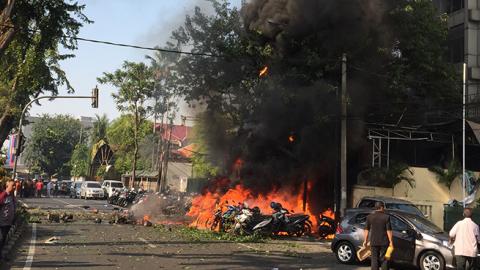Last weekend’s seven bombings in Surabaya reveal a marked escalation of ISIS capabilities in Indonesia and also show changes in tactics. This is probably only the first wave of awaited attacks by ISIS returnees from the Middle East. Nevertheless, the terrorism threat in the country remains small.
On Sunday, May 13, three churches were bombed in Surabaya, Indonesia’s second largest city. The first explosion took place at Saint Mary Immaculate Catholic Church. Five minutes later, there were explosions at Surabaya Pentecostal Church and the Diponegoro Indonesian Christian Church. These have been widely reported, but there were also two other attempted church bombings—Saint Jacob’s Church at the Citraland housing complex in West Surabaya and the Sacred Heart of Jesus Cathedral. Thankfully, the bombs failed to explode.
Following ISIS’ pattern of planning coordinated assaults, there were two further attacks. On Sunday evening, a bomb went off at the low-income Wonocolo apartments in the Sidoarja area, killing three members of a family of five. Security officials believe that the bomb exploded prematurely and that the deceased family members were actually the terrorists themselves, whose intended target was the nearby Taman Police station. The explosive used at the apartments was the same type of explosive was used as in the church bombings. Then, on Monday morning, there was another bomb attack, this one at the Surabaya Police headquarters, in which four police officers and six civilians were injured. As of Monday afternoon, Surabaya time, the weekend’s total carnage was 25 dead; 13 of the dead were the suicide bombers themselves.
ISIS has credibly claimed responsibility for the attacks, and security officials have stated that the bombers were among ISIS-affiliated Indonesians deported by the Turkish government in 2017. Less credibly, ISIS had previously claimed responsibility for the May 8 riot at the maximum-security Mako Brimob prison facility in South Jakarta, Indonesia’s main prison for terrorists, in which five guards and one prisoner were killed. However, whether or not ISIS has genuine responsibility for all its claims, the Surabaya bombings are the culmination of a series of attacks that began in January 2016 with the bombings at the Sarinah shopping mall in Jakarta. The Sarinah mall bombings were the first to be claimed by ISIS.
These most recent attacks appear to represent a subtle, albeit savage, shift on the part of ISIS in the method and the focus of their violence.
Changing Methods
One unique feature of the attacks is that they were carried out by families, including children. ISIS has used women and children in its attacks before, but seldom has it employed whole family units to carry out terrorism. The three church bombings appear to have been carried out by only one family, in which the father bombed the Surabaya Pentecostal Church, while his two teenage boys bombed Saint Mary Immaculate Church, and the mother and her two young girls bombed the Diponegoro Indonesian Christian Church. The father had allegedly dropped off his wife and two daughters, aged nine and 12. In the premature explosion in Sidoarja, three terrorists were killed—a mother, father, and the eldest son, while other children were severely injured. The attack on the Surabaya police headquarters also seems to have been carried out by a family. CCTV footage indicates that the explosion came from a motorcycle driven by a man, with a woman and child sitting behind in the passenger seat. It remains to be seen whether this change in tactics will be repeated elsewhere.
Changing Focus
Another unique feature in the recent carnage is the focus on churches. There were attacks on police stations, but five of the seven attacks were on Christian houses of worship, as was the November 2016 attack in Kalimantan. Of course, ISIS has always defined itself and its targets religiously—in its own mind all of its attacks are against “polytheists,” “heretics,” and “apostates.” Thus, it disproportionately targets religious minorities such as Christians and Yazidis, as well as Shia and Sunnis who reject their view of Islam. It often describes its European victims indiscriminately as “worshippers of the cross,” and it has targeted priests. But this concentrated focus on attacking churches per se is a step further, and this too may be repeated elsewhere.
Cause for Alarm?
While widespread attacks in the space of 24 hours show increasing ISIS capabilities, the attackers also had a high degree of incompetence. Three of the seven bombs failed to ignite or went off prematurely. Over half of those killed were the presumed terrorists. This was also true of a January 2016 attack on the Sarinah mall: of the eight people killed in that attack, half were the terrorists themselves. Other groups claiming allegiance to ISIS have been stragglers hiding out in jungles in Sulawesi and surviving by stealing from local villages.
This current low level of operational skill is one reason not to exaggerate the current terrorist threat in Indonesia, although the level of competence will very probably increase. The aggressive major anti-terrorism unit, Densus 88, has also had a significant impact. But a major reason is the dominant local forms of Islam. There is increasing radicalization and religious polarization in Indonesia, but the major Muslim organizations have rejected radicalism and terrorism, thus limiting ISIS’ recruiting pool. Muslims from Indonesia have been about 70 times less likely to join ISIS than Muslims from many European countries. Hence, the number of returnees from the Middle East is comparatively much smaller.
As more ISIS recruits return, terrorism in Indonesia is likely to increase in both number and potency of attacks. And the focus of assaults on Christians adds additional worries of polarization in this multi-religious society. But, so far, the threat should not be exaggerated. In the last decade, deaths from terrorism in Indonesia are still less than in Belgium, France, or the United States.

















